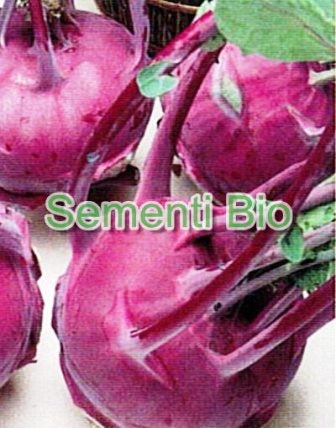PURPLE VIENNA KOHLWATER - 1355
Have a question?

PURPLE VIENNA KOHLWATER - 1355
Dettagli
Kohlrabi ( Brassica oleracea acephala gongylodes)
Brief history and botanical notes on the plant
Kohlrabi is a variety of cabbage with an edible, swollen stem, green or purple. Its pale green leaves are lobed at the bottom. The lower part of the stem, enlarged, resembles a large turnip, whose flavor it also resembles. Early varieties have a more delicate flavor and can be grown in a greenhouse or outdoors if there is no danger of frost. Late varieties are suitable for longer storage. Kohlrabi belongs to the Cruciferae family and is widespread especially in southern Italy. The best-known varieties are the white Vienna and the purple Vienna, which, in terms of taste, do not present major differences. Raw kohlrabi can be prepared in a salad or, if cut into strips, enjoyed with sauces. To prepare it as a vegetable or in soup, brown it or steam it. Stuffed kohlrabi (steam it briefly first) is a very tasty dish. Kohlrabi, rich in vitamins, can be bitten like an apple. Kohlrabi (Brassica oleracea acephala gongylodes) is native to south-western Asia and differs from other cabbages because it has an enlarged and rounded stem, green or purple in colour, on which a few lobed leaves form, equipped with a long stalk . It is widespread especially in southern Italy and the edible part consists of the stem, more or less the size of a large grapefruit and similar to a turnip. The nutritional properties and the vitamin (especially vitamin C) and mineral (especially phosphorus and calcium) intake
Property
Kohlrabi is quite rich in vitamins, it contains vitamin C, beta-carotene, which in the body transforms into vitamin A, folic acid and small doses of group B vitamins. The tender leaves of kohlrabi are richer in mineral salts than the root enlarged. For this reason it is advisable not to throw them away. 100 g contains 1.9 g of protein, 0.2 g of fat, 3.7 g of carbohydrates, 100 kJ/24 kcal.
It adapts to all types of soil, although it prefers those with a neutral reaction, fresh, well-drained and deep.
Sowing and transplanting times
It is grown with an autumn-winter cycle, often after a spring-summer crop.
It is sown, or more often transplanted, from July to September, in rows 50 cm apart, with a distance on the row of 30 cm.
Less frequent, but used in the south, is early sowing in January to obtain spring production.
Processing
Turnip greens cannot tolerate water stagnation, therefore processes that favor aeration of the soil, weeding and weeding, are important, and are also used to control weeds.
Fertilizations
An undemanding plant, it prefers the use of well-matured manure, which is buried in the plant at a rate of 3 kg/m2.
Crop care and irrigation
The plant also suffers from stagnation and water stress: it therefore requires moderate and frequent irrigation.
Adversity
Good cultivation practices such as rotation, the use of mature compost, correct and timely irrigation, ensure the success of the crop.
It is a plant that is very resistant to fungal attacks, which rarely cause serious damage or drops in crop production.
Instead, it fears various insects: aphids, the cabbage fly and the cabbage larva. Mixing with garlic, onion and leek is recommended as they tend to keep them away.
Defense products
No particular problems are encountered in biodynamic gardens, therefore we recommend correct use of biodynamic preparations also as prevention.
In rotation it must not follow cucurbits, umbellifers, nightshades or crucifers because it shares some parasites with them.
Production and collection
The harvest is carried out before the flower buds open, which depreciates the quality of the product, making it barely edible.
This occurs approximately 60 days after transplanting for early cultivars, 90/120 for late ones. The plants are cut 10 cm from the ground, thus encouraging the growth of secondary inflorescences; therefore more cuts are made during the cultivation cycle. The stems are then tied into bunches.
Production is approximately 200 q/ha, depending on the number of mowings carried out. After harvesting, turnip greens can be stored for a maximum of 2/3 weeks at refrigeration temperature, under penalty of yellowing of the leaves which causes the onset of a bitter taste, and the consequent commercial depreciation of the product
Biodynamic treatments
Spray the preparation 500 before main processing and weeding.
Use of the biodynamic calendar
Carry out weeding, weeding and transplanting in the descending moon; all these interventions must be carried out on leaf days.


